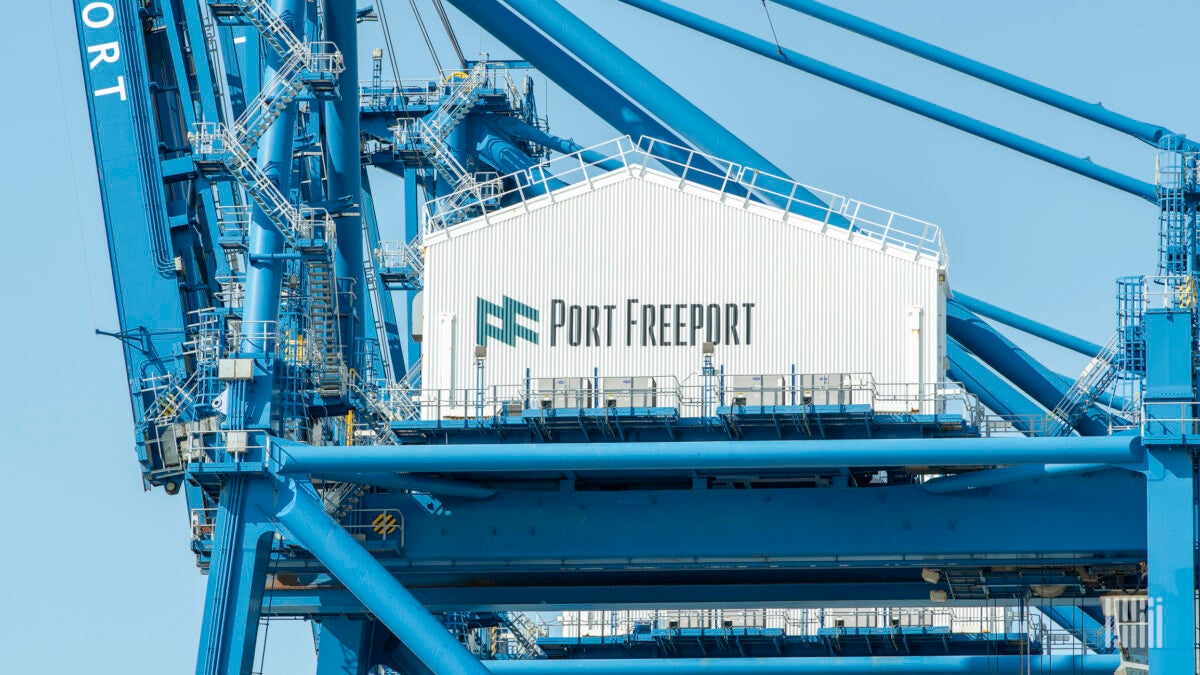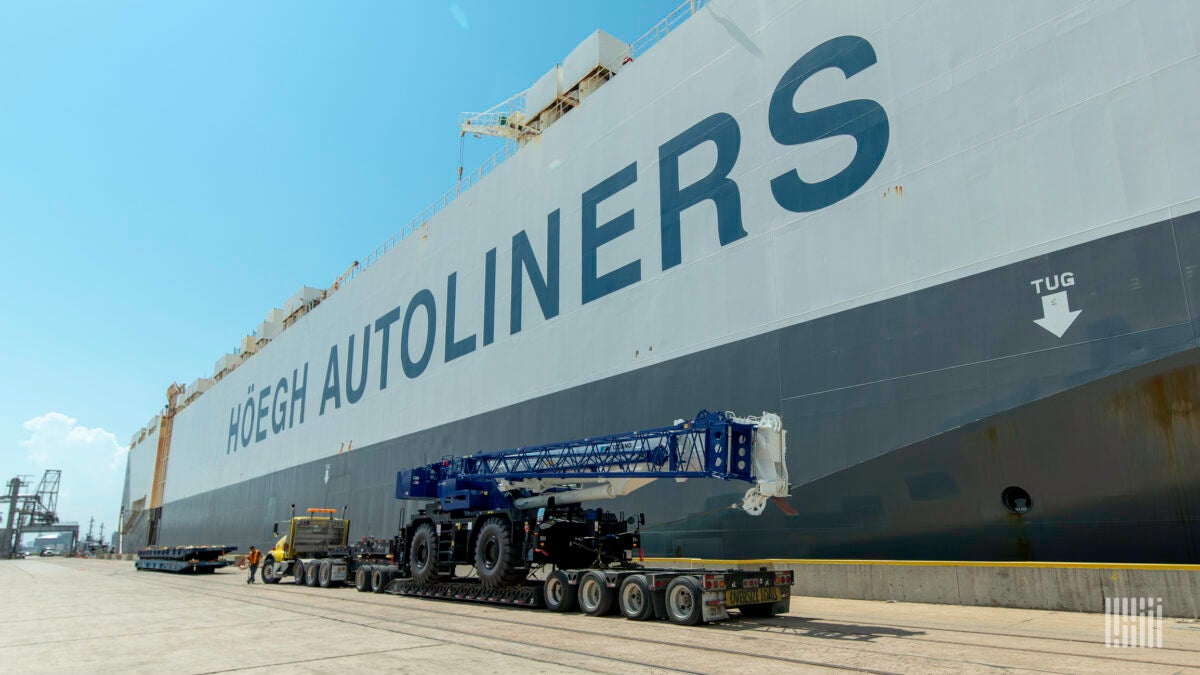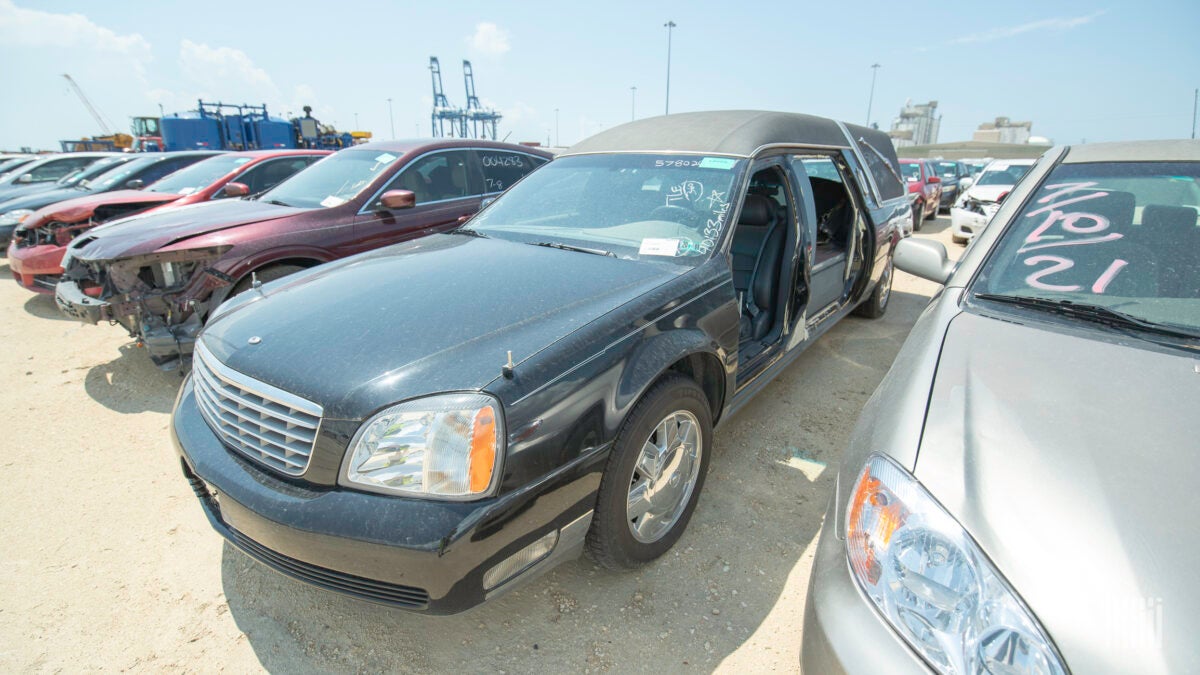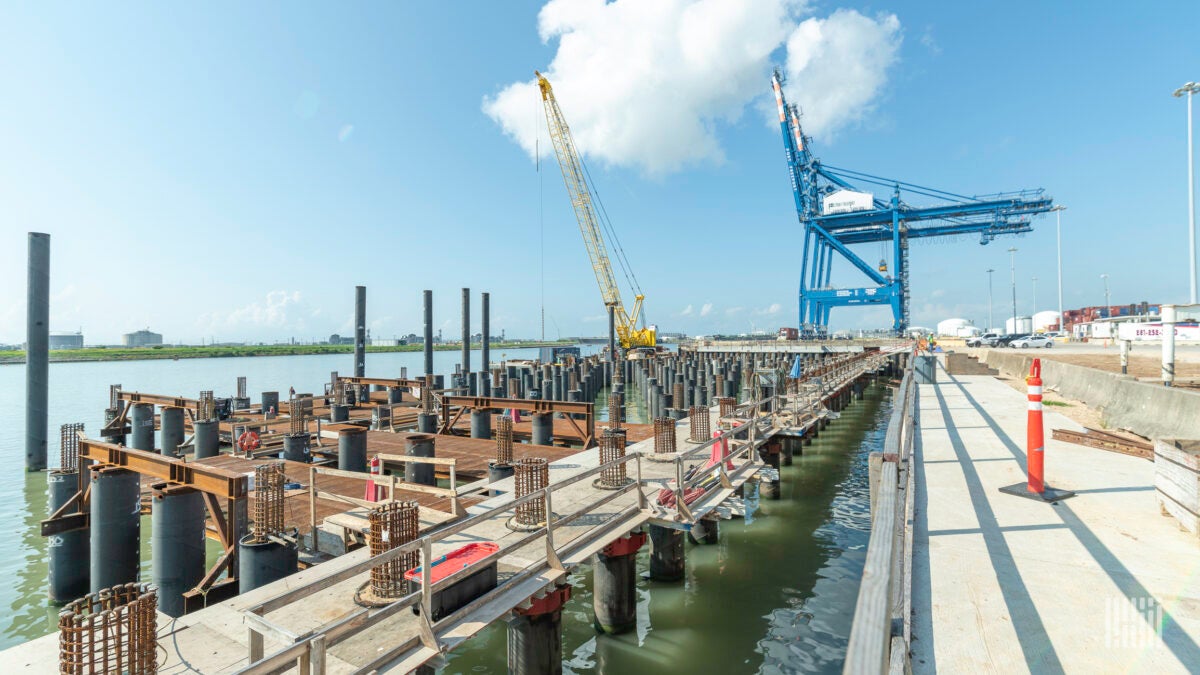FREEPORT, Texas — Located in southeast Texas where the Brazos River empties into the Gulf of Mexico, Port Freeport is one of the ports best poised to accommodate bigger ships crossing the enlarged Panama Canal, officials say.
It is one of several ports that have embarked on massive expansion projects in recent years, anticipating more traffic and larger vessels coming through the canal.
“The canal’s expansion is a big part of our growth,” Cecil Booth, project engineer at Port Freeport, told FreightWaves during a recent tour of the facilities. “The ships that are sailing on the sea now are getting bigger, with deeper drafts, longer and wider. So in order to accommodate the deeper draft ships, Port Freeport elected to deepen the channel and widen the channel.”
The canal expansion, completed in 2016, has opened the Gulf of Mexico to Neopanamax ships, as well as very large crude carriers (VLCCs), capable of hauling millions of barrels of crude oil.
Neopanamax ships are next-generation ships built to use the widened Panama Canal. That allows increased cargo and more container revenue for U.S. ports.
Port Freeport has several major projects underway, including the channel-deepening and an expansion of its container terminal.
“Shipping has become a big containerized process all over the world. To be able to compete in the container market, Port Freeport elected to expand their container port,” Booth said.
Other ports across the Gulf Coast aren’t resting on their laurels either. Ports from Brownsville, Texas, to New Orleans, to Mobile, Alabama, are expanding and will spend about $5.4 billion on expansion projects by 2027.
| Port of New Orleans (cost: $1.5 billion) |
| The Louisiana International Terminal project will build a 350-acre container terminal with a 3,500-linear-foot wharf on more than 1,000 acres, aimed at handling 2 million twenty-foot equivalent units annually. Completion scheduled by 2027. |
| Port of Beaumont ($1.2 billion) |
| The Sabine-Neches Waterway, which connects this East Texas port to the Gulf of Mexico, is undergoing a deepening of its 57-miles of waterway to allow larger ships to move in and out. Completion is expected in 2027. |
| Port Houston ($877 – $1 billion) |
| The Project 11 program will deepen and widen the Houston Ship Channel to handle two-way traffic of next-generation-size containerships. Completion is scheduled by 2027. |
| Port of Corpus Christi ($651 million) |
| The Corpus Christi Ship Channel Improvement Project in Southeast Texas will widen and deepen the channel in order to accommodate very large crude carriers (VLCC) for crude oil export. Scheduled for completion in 2023. |
| Port Freeport ($424 million) |
| The $130M Velasco Terminal expansion project will support container roll-on/roll-off cargo. The $295M Freeport Harbor Channel Deepening and Widening project is aimed at accommodating post-Panamax container vessels and post-Panamax tankers. The $41.8M Parcel 14 Stabilization project will construct a 200-acre multi-modal facility with more rail capacity. Completion will be about 2025. |
| Port of Mobile ($366 million) |
| The Alabama Seaport Modernization Program for the Mobile Ship Channel will deepen and widen Mobile Bay and existing river channels to accommodate larger container ships from the Panama Canal. Completion is scheduled for 2025. |
| Port of Brownsville ($350 million) |
| The Brazos Island Harbor Channel Improvement Project in South Texas will deepen the port’s 16-mile ship channel from 42 feet to 52 feet to accommodate larger container and tanker ships. Scheduled for completion in 2024. |
| Port of Port Arthur ($55 million) |
| The Berth 6 Expansion project for this East Texas port will create a new wharf and deepen the port’s channel to add capacity and increase berth capability for larger ships. The projected completion is 2023. |
The Port of New Orleans (Port NOLA) is in the planning stages to build the $1.5 billion Louisiana International Terminal, which will be capable of handling 2 million twenty-foot equivalent units annually.
“This is the largest project and biggest investment Port NOLA has undertaken in dollars,” Jessica Ragusa, spokeswoman for the port, told FreightWaves.
The Louisiana International Terminal’s plans call for a 350-acre container terminal with a 3,500-linear-foot wharf on more than 1,000 acres of developable greenfield property “to serve the industry’s largest container vessels,” Ragusa said.
“The Panama Canal expansion as well as larger ship sizes were big reasons in deciding to expand Port NOLA downriver from our current container terminal facility uptown,” Ragusa said. “Container cargo vessels are getting larger and require deep water and enough space for ships to dock.”
The Port of New Orleans will also be adding four ship-to-shore gantry cranes to its Napoleon Avenue Container Terminal, which is in the process of a $100 million expansion that will increase the ports container capacity to 1 million TEUs.
The four gantry cranes slated for the Napoleon Avenue Container Terminal are currently being fabricated in China.
“With the new cranes, the facility will have a total of nine container gantry cranes. Our container business has doubled in 10 years and market demand continues to grow,” Ragusa said. “The business is ours to lose to other states if we don’t provide the infrastructure necessary to compete in the future.”

While Freeport is a small, sleepy Texas town known for its beaches, saltwater fishing and chemical refineries, the port has several big advantages over many other larger installations — deep water close to shore and a shorter distance to the open waters of the Gulf, Booth said.
Freeport is located about 60 miles south of Houston.
“From dock to deep water, the distance is around 5 miles, so it’s very, very close,” Booth said. “It’s close enough where ships are not stacked up waiting for their turn to get in or waiting your turn to get out. It’s a short turnaround to get into open water and go on, whereas some of these other ports are way upriver or way up the channel.”
Port Freeport currently is the 25th-ranked seaport in the U.S. by total trade and 54th overall among the nation’s roughly 450 airports, seaports and border crossings, according to U.S. Census Bureau data analyzed by WorldCity.

Port Freeport was the fourth-ranked seaport in Texas in May, with $1.5 billion in two-way trade, behind Port Houston ($14.2 billion), Port of Corpus Christi ($4.3 billion) and Port of Port Arthur ($1.7 billion).
Port Freeport was founded in 1925 and generates an economic impact of $46 billion annually. Over 900 vessels per year call the private and public terminals in the port, handling over 17 million tons of cargo.
The port offers container, general cargo, breakbulk and roll-on/roll-off (ro-ro) services. Its customers include Atlantic Container Lines, AMPORTS, BASF, Chiquita Fresh, Dole Fresh Fruit, Dow Chemical Co., Exxon Mobil, Freeport LNG, Phillips 66, Riviana Foods, Tenaris and Vulcan Materials Co, among others.
Ro-ro cargo has been one of Port Freeport’s fastest growing segments over the last several years. The port has seen a $400 million increase in automobile imports since 2018, and has been exporting close to $1.5 billion in autos assembled in Texas annually.
New cars arrive from Arlington, Texas, and are exported mostly to the Middle East. New imports arrive primarily from South Korea and India. Used cars are shipped off to West Africa, Booth said.
“We get upwards of three ro-ro ships a week,” Booth said. “That’s the reason we decided to put an additional railroad dock out here, because we need to be able to handle more than one ship at a time.”

In April, Port Freeport began the $295 million Freeport Harbor Channel Improvement Project, a channel-deepening initiative that will take about five years to complete.
Last year, Port Freeport also began a $130 million project to expand its Velasco Container Terminal. The terminal expansion involves building 1,600 feet of new berths, including one (Berth 8) that will be dredged to 51 feet to allow larger container vessels to call the port.
McCarthy Building Cos. is constructing the Velasco Terminal Expansion project. Fitz O’Donnell, SVP, marine and industrial business unit leader for McCarthy’s Houston office, said marine construction projects have become more expensive and complex over time.
St. Louis-based McCarthy, founded in 1864, opened a marine and industrial division headquarters in the Houston area in 2019. McCarthy currently has projects ongoing at Port Houston, and has executed three different projects at the Port of Port Arthur in Port Arthur, Texas.
“A lot of projects, they’ve definitely gotten bigger,” O’Donnell said. “As time goes on, things get more expensive. Ten years ago, we paid $85 a cubic yard for ready mix concrete. These days, we might be paying $130 a cubic yard. That’s just what the industry does. We use a lot of steel in these projects, which is a very volatile commodity, especially this year. So that’s a challenging piece of it.”
The Velasco Container Terminal expansion will include 29,200 tons of steel piling, which will require a three-story construction template to ensure accurate alignment. In addition to the piling, 60,000 tons of revetment rock is to be placed in between the piles.
“The purpose of the template is to make sure that the pilings can be surveyed in and put in the exact location that they should be, while at the same time, provide access so that our pilot crews can get to them to actually drive them in,” O’Donnell said. “It has to be very precise, there’s a little bit of tolerance, just because of the nature of the work. But you know, when you have 1,000 of them to put in, it’s worth spending time on the front end to get the right template.”
O’Donnell said one of the best parts of his job is watching projects come to fruition.
“That’s one of the fun things, being a part of this and building something for a fantastic client and just seeing these big ships come in and how just efficiently they’re able to load them and unload them and move cargo. It’s fantastic. It’s great,” O’Donnell said.
The Velasco Terminal Expansion will add two more cranes for post-Panamax vessels to Port Freeport, in addition to the two already there.

Once the expansion is complete, container capacity at the port will grow tremendously. In 2017, Port Freeport handled about 100,000 twenty-foot equivalent units. Once the Velasco Container Terminal expansion is complete, Port Freeport officials expect to see up to 2 million TEUs per year.
“We’ll be able to put two ships at the dock,” Booth said. “Potentially we could get another freight liner, another carrier, in here. That will mean more work, jobs, the people that work out of those ships, stevedores, longshoreman, they’ll have to gear up, and we’ll have more people driving the trucks doing the work that’s done to load and unload the ships.”
Click for more FreightWaves articles by Noi Mahoney.
More articles by Noi Mahoney
More investment, manufacturing jobs for Mexico










